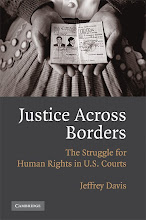When many think of human trafficking, they imagine their
favorite episodes of Law and Order or
other television depictions. But in reality, human trafficking has a farther
reach and is far darker than Hollywood would lead one to believe. It has
existed for thousands of years, throughout virtually every country in the
world. Human trafficking, as defined by many outlets, is the illegal movement
of people, typically for the purposes of forced labor or commercial sexual
exploitation. Many also describe human trafficking as modern day slavery.
Human trafficking is an injustice for many reasons.
Trafficking is an exploitative and traumatizing process, and many are targeted
specifically for their vulnerability. Another important problem is the fact
that the victims are often prosecuted themselves. Sex slaves are often targeted
as “prostitutes” and rounded up in police stings. Beyond this, those who are
trafficked are rarely given the tools they need to survive after being
convicted of prostitution such as rehabilitation, counseling, and job training.
Even though the trend to catch so-called “Johns” (men who pay for sex) in such
stings is increasing, the legal problem for those being trafficked is far from
resolved.
The most serious crime involved with human trafficking is
being the head of a trafficking ring or “pimp,” which is a felony, but they are
notoriously hard to catch and prosecute. In the United States federally, there
were 1,927 investigations with 232 prosecutions (charging 253 defendants) in
2013, resulting only in 174 convicted traffickers altogether (2014 TIP report).
Maryland is having to investigate these crimes in great magnitude, as the BWI
area is increasingly becoming one of the biggest hot spots for trafficking in
the United States due to its proximity to an airport, hotels, and I-95.
While it is very difficult to undo what damage has been done to victims of human trafficking, there are still ways to remedy this injustice. Most solutions are victim-centric: instituting post-conviction reviews and alternative disciplinary measures for those who have been arrested for prostituting. There is also the option of founding or implementing rehabilitative treatment and other programs in order to help victims recover and assimilate into normal lives. As stated above, it is very difficult to find and expose human trafficking rings, but not impossible. Toughening the laws and punishments for those who are convicted of running a sex trafficking ring or soliciting sex would focus law enforcement resources away from victims and towards those running organized prostitution rings. A 2007 New York State law increased the penalties from 15 to 25 years for those charged with pimping, and increased penalties from 90 days to up to 1 year for those convicted of soliciting a prostitute. This law was instrumental in dismantling a large prostitution ring in New York in 2012.
Human trafficking is one of the most widely-committed and
dangerous crimes of the modern world. However, there is hope for the victims:
organizations such as Hope for Justice and the Salvation Army spend countless
hours fighting human trafficking and helping to rehabilitate victims in the
United States and abroad. Those interested can donate money or volunteer their
time to work with these organizations. The Maryland Human Trafficking Task
Force also dedicates itself to eradicating trafficking in Maryland. In the
Maryland General Assembly, several bills are being considered to help victims
of human trafficking. HB 623 would allow for a post-conviction review of a
person arrested who is revealed to be a victim of human trafficking. HB 786
would extend the sunset provision of the workgroup to study the safe harbor
policy for youth victims of human trafficking. Finally, HB 1273 would train
school staff in Anne Arundel County Public Schools to recognize the signs of a
youth being trafficked. These bills have not yet gone to committee, so students
can still write in to their legislators to express support for these bills.
More information can be found at http://mgaleg.maryland.gov/webmga/frm1st.aspx?tab=home.


No comments:
Post a Comment